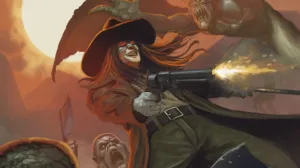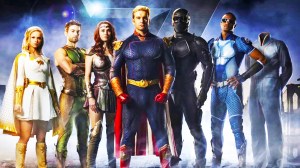Massive Entertainment seemingly set out to not only continue what they started with Tom Clancy’s The Division, but also improve upon it in ways that make sense to the overall tone of the series as much as it does to fans. The Division 2 has done exactly that, bringing to fruition a wonderful experience based on player feedback from the first title as well as implementing new ideas.
Videos by ComicBook.com
Seven months have passed since the first game’s events, with players now finding themselves in a rundown, violence-riddled D.C. It is now up to you to ensure Washington does not collapse by fighting off factions, saving civilians, and most importantly, looting and shooting.
While the setting isn’t exactly groundbreaking, what makes The Division 2 special is its ability to appeal to a myriad of players with different styles. Want to be the lone wolf and claim glorious victory for yourself? You can absolutely do that. There will be a struggle as the game progresses, but it is doable.

Flying solo is only as feasible as it is in The Division 2 because of the well-tuned balance of the game’s progression system. Enemies, weapons, and gear are all scaled with one another to a degree that presents a challenge, but doesn’t make things seem impossible. Another advantage to this is that enemies don’t feel like bullet sponges at any point throughout the game. Instead of sinking multiple magazines into one enemy, a few well-placed headshots should suffice. That is, of course, against your standard enemies. The heavily armored ones may require a bit more finesse, but it feels more rewarding than anything when you take them down as opposed to feeling like you’ve just wasted a mountain of ammo.
As for co-op and multiplayer, it’s been made abundantly clear that joining others is the way to get the most out of The Division 2. Having a team makes everything run a bit smoother, XP and levels are gained quicker, and there is definitely not as much respawning as compared to a solo approach. That said, running around with others can be difficult if you don’t already have friends playing the game. On the other hand, you are able to call for backup if a particular situation is more than you bargained for, and should others in the area choose to answer that call, you’ve just found some squadmates.
For my part, I’m a solo player through and through, but when things went sideways, I did not hesitate to call for backup. However, sometimes the player pool felt a bit slim as it could take upwards of 20 minutes to find someone else to team up with. One feature that would be nice to see here is something similar to the AI backup that comes to your side when attempting to capture a control point, just in case nobody answers that call.

Speaking of AI, the NPCs are vastly improved in The Division 2. Instead of just existing in the world around you, they help bring it to life. Various groups can be found walking around D.C. with different tasks that they are completing to better their settlements, and you can join along if you so choose. They really help provide the game with a sense of realism as the communities feel authentic, with everyone coming together to provide for one another. They are not just surviving in this dilapidated version of D.C., but thriving as well. It’s a level of comfort one would not expect from this sort of environment, but it is inviting and makes you want to do your best for the people around you.
How you are able to help these people is through the grind featured in The Division 2, which doesn’t feel like much of a grind at all. The pacing of everything combined with the balanced progression system makes for an incredibly enjoyable experience. At no point did I ever feel like I was just grinding away at better loot or more materials to donate and craft with. This could very well have to do with the vibrant life that is flowing through the settlements and how it feels like you are one of them, or it might have something to do with the massive world that is filled to the brim with loot.
The world of The Division 2 is large and open, especially when you are travelling by foot. This is also apparent when you run into enemies every few minutes, making your treks take even longer than anticipated. Luckily, Fast Travel exists, and it’s something you will want to use if you are looking to get things done in a timely manner. If that’s not the route you want to go, there’s a very large area to roam around in, in which you can collect all of the loot, come across all of the dogs you are not allowed to pet, disrupt enemy shenanigans, assist allies, and so much more. The Division 2 is packed with content from start to endgame, and then there’s more.

Once you’ve completed the main campaign, your endgame journey begins. The Black Tusk faction invades the entire map, presenting players with challenges far more difficult than the main game. This is when you’ll really want to gather some friends for a little co-op action, because going it alone is not exactly fun after this point. Challenging, yes, but it becomes the bad and frustrating part of the grind, so it’s best to call in backup.
Massive was clear that it put a heavy focus on the game after the game, and the company didn’t pull any punches when it comes to endgame content this time around. A few things of significance change once you reach this point as well. Specializations are now unlocked, with each having its own Signature weapon. (Hello there, crossbow.)
Additionally, at this point a player’s level is transformed into a Gear Score, which will play a part in what challenges you encounter during the endgame. World Tiers are now available as well, which sort of act as levels, but in order to reach the next one, you’ll have to dispatch an invaded Stronghold. To put it simply, Black Tusk is everywhere.

The Division 2‘s story may be its weakest point, which is saying something, because there is plenty of story to tell. There are a number of cell phones and the like around the city that help explore the narrative of not only what is going on in D.C., but the events of the first game. Add to this cutscenes and NPCs galore; it’s all there, you’ll just have to piece it together. This may be the weakest point, but it is certainly not for lack of trying. The exploration, looting, and shooting, however, just seem to add a bit more to the experience than the story does, and that’s not a bad thing.
Overall, The Division 2 feels like a complete game, which is seemingly becoming more and more uncommon these days. And while there is more to come, what has been presented at launch is more than enough for fans to sink their teeth into. With a hefty main campaign and a plethora of endgame content, The Division 2 not only improves upon its predecessor in nearly every way, but it also provides an experience that is well worth the price of admission.
Rating: 5 out of 5
The Division 2 is currently available on PC, PlayStation 4, and Xbox One. A PC review code was provided by the publisher for the purpose of this review.








